Nine Classes of Angelic Beings in Three Groups
Man as the Tenth (becoming) Hierachy
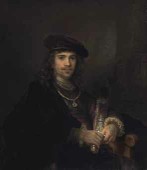
Rembrandt van Rijn (15 July 1606 – 4 October 1669)
When Rembrandt van Rijn paints a man in armor it reflected his „hidden“
intention to portrait Christian Rosencreutz; or a homage to Archangel Michael.”

Traditionally, all Archangels, like Raphael, Uriel, Gabriel, are painted as angelic beings, dressed by beautiful, loose hanging veils in light pastel colors. The only exception is Archangel Michael. He is presented by a human being (St. George) or angelic being, dressed for battle and with a fiery sword or spear (which stands for the human Ego, or spirit that reincarnates; also the Head of all Gods in Germanic mythology Wotan carries a spear when he wonders incognito over the globe).
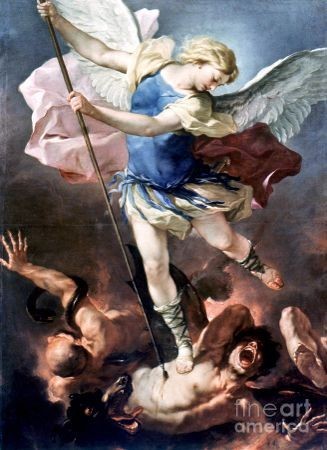
In the Jewish tradition, Archangel Michael is mentioned three times in the Book of Daniel, once as a “great prince who stands up for the children of your people”. The idea that Michael was the advocate of the
Jews became so prevalent that in spite of the rabbinical prohibition against appealing to angels as intermediaries between God and his people, Michael came to occupy a certain place in the Jewish liturgy.
In the New Testament, Archangel Michael leads God’s armies against Satan’s forces in the Book of Revelation, where during the war in heaven he defeats Satan. In the Epistle of Jude Michael is specifically referred to as “the archangel Michael”.
Christian sanctuaries to Michael appeared in the 4th century, when he was first seen as a healing angel, and then over time as a protector and the leader of the army of God against the forces of evil. By the 6th century, devotions to Archangel Michael were widespread both in the Eastern and
Western Churches. Over time, teachings on Michael began to vary among Christian denominations.
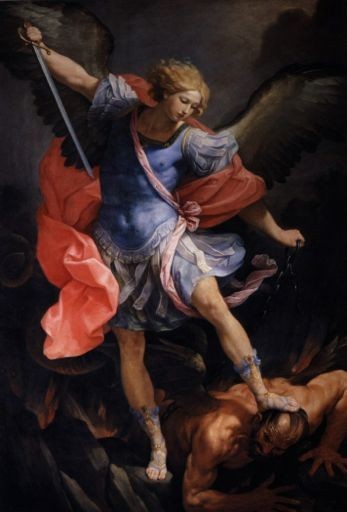
Guido Reni’s archangel Michael (in the Capuchin church of Santa Maria della Concezione, Rome, 1636) tramples Satan (Ahriman).
The psychostasia (Greek for ‘weighing of souls’), is a method of divine determination of fate, which persists from the Iliad throughout Christian theology.
During the contest of Achilles and Hector in the Iliad, Zeus, wearying of the battle, hung up his golden scales and in them set twin Keres, “two fateful portions of death”; this, then, is known as the kerostasia. Plutarch reports that Aeschylus wrote a
play with the title psychostasia, in which the combatants were Achilles and Memnon. This tradition was maintained among the vase painters. An early representation is found on a black-figure lekythos in the British Museum; she observes “The Keres or φυχαί are represented as miniature men; it is the lives rather than the fates that are weighed. So the notion shifts.”
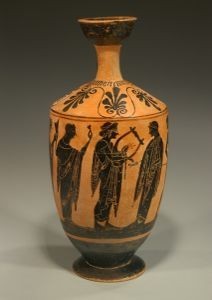
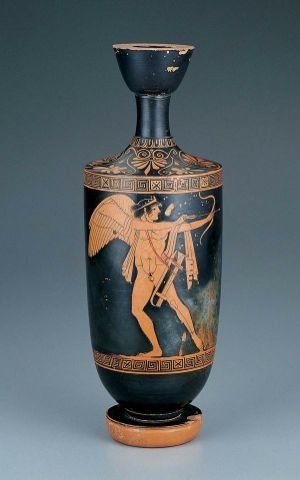
In a psychostasia on an Athenian red-figure vase of about 460 BCE at the Louvre, the fates of Achilles and Memnon are in the balance held by Hermes. Among later Greek writers the psychostasia was the prerogative of Minos, judge of the newly deceased in Hades.
In Egyptian mythology, where Duat is the Underworld, there would take place the Weighing of the Heart, in which the dead were judged by Anubis, using a feather, representing Ma’at, the goddess of truth and justice responsible for maintaining order in the universe. The heart was the seat of th oiri Hearts heavier or lighter than the feather of Ma’at were reje 6/44 a Ammit, the Devourer of Souls.
For Christians, among the terrors that wait at the Day of the Last Judgment is the weighing of souls. Sin is heavy, and sinful souls are to be consigned forever to Hell. The courtly angelic knight in the central panel of Hans Memling’s The Last Judgment, ca 1470 (National Museum Gdańsk), is the Archangel Michael, who separates the “Just” from the “Damned” in his steelyard balance. Memling has treated a medieval genre of fresco, called in
English examples a “Doom” which kept the future terrors before the eyes of the faithful.

Hans Memling (ca. 1430-1494) was a German-born painter who moved to Bruges in Flanders at a young age and worked in the tradition of Early Netherlandish painting. Notice here the angels from above with the trumpets who represent the Seraphim, angelic beings belonging to the highest of all hierarchies. The Seraphim and the Cherubim guide one’s karma on earth in daily human life but execute the division between the “good” and the “evil” at the Day of Judgment. Archangel Michael is the center figure in armor below the Risen Christ who directs the Last Judgment.
In ancient Egyptian tradition, Archangel
Michael is called Aten (a Sun God, representing the Sun as a dwelling place for a high Deity; the Christ) under the Pharaoh Akhenaten. Or, Atum or Auf as an aspect of the Sun God Ra: the Ram Headed God who wears a Solar disk.
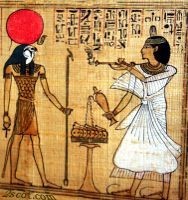
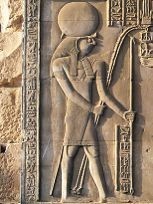
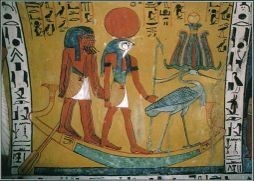
One of the most important deities in Egyptian mythology, the sun god Ra (or Re) was the supreme power in the universe. The giver of life, he was often merged with the god Amun as Amun-Ra. Some myths present Ra as the head of the Egyptian pantheon and ruler of all the gods. Others say that he was the only god and that all other deities were merely aspects of Ra. Here, Ra travels across the sky during the day and through the underworld at night. This tomb painti-of the ca. 1200th century B.C. shows Ra with a sun disk In some Egyptian creation myths, Ra emerged from either a primeval mound or primeval waters as Ra-Atum and created Tefnut (the element water) and Shu
(the element air). From this first divine pair sprang the sky goddess Nut and earth god Geb, who created the universe and gave birth to the gods Osiris*, Isis*, Set*, Nephthys, and Horus.
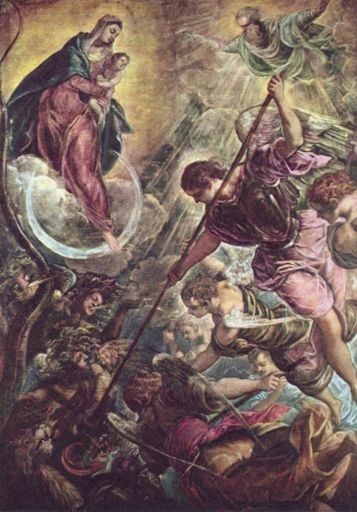
Tintoretto(1518–1594),real name Jacopo Comin
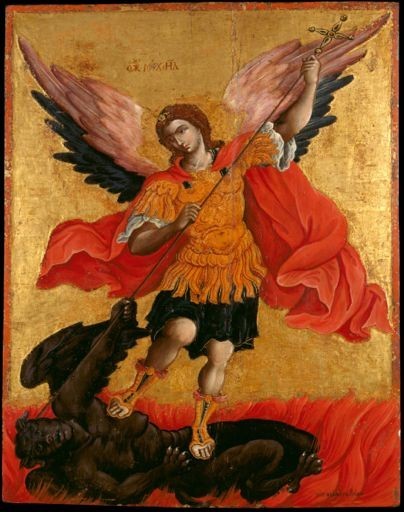
Ancient icon(ca.1600 A.D.) in the Greek Orthodox tradition of Archangel Michael fighting Satan (Ahriman)
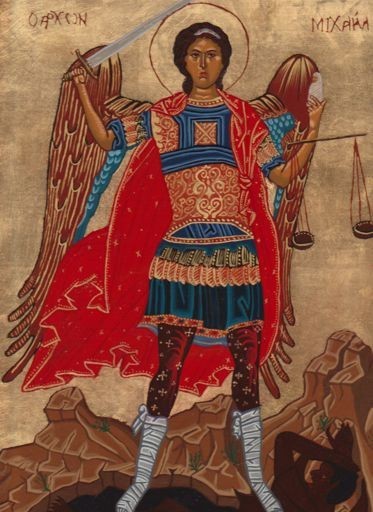
Icon with Archangel Michael carrying not only a sword but also a balance as symbol of (speaking) justice. In Pharaonian tradition, the first Deity the recently diseased would meet was Archangel Michael who would judge the deeds and intentions of the diseased.
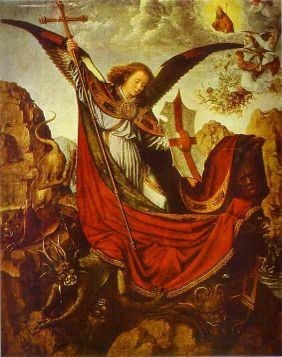
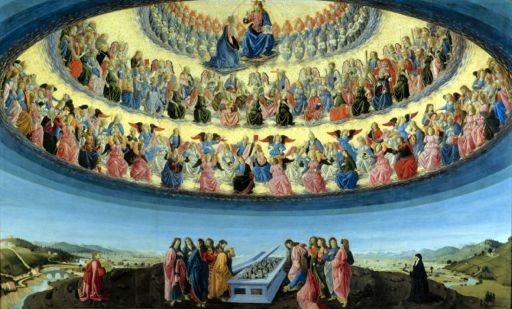
Notice the three hierarchies, each consisting of three classes of angelic beings with the Risen Christ at the center and the top.
The most influential Christian angelic hierarchy was tha al Pseudo-Dionysius the Areopagite in the 4th century in his book “De Coe. Hierarchia” (On the Celestial Hierarchy).
During the Middle Ages, many schemes were proposed, some drawing on and expanding on Pseudo-Dionysius, others suggesting completely different classifications. According to medieval Christian theologians, the angels are organized into several orders, or “Angelic Choirs”. The concept of “Choir,” namely singing and playing music by nine classes of angelic beings, roots in the concepts and teachings of Pythagoras, who described that when one enters consciously the spiritual world one enters
the spheres of “harmony” or “symphony” where Cosmic Harmony is first experienced as a massive harmonious “Symphony” beyond imagine. Therefore, each class in the hierarchies has been contributed a different musical instrument.

Seraphims surround the divine throne in this illustration from the “Petites Heures” de Jean de*Berry, a 14thOcentury illuminated manuscript.
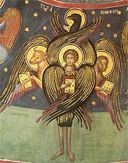
A cherub, as described by Ezekiel and according to traditional Christian iconography. Notice the symbols for the Gospel of St. Luke (Taurus), Lion, Eagle (its shadow on earth is Scorpio) and the human face (Aquarius)
Pseudo-Dionysius (“On the Celestial Hierarchy”) and Thomas Aquinas (Summa Theologica) drew on passages from the New Testament, specifically Ephesians 1:21 and Colossians 1:16, to develop a
schema of three classes or spheres of Hierarchies, with each Hierarchy containing three Orders or Choirs. Although both authors drew on the New Testament, the Biblical canon is relatively silent on the subject.
First Hierarchy (consisting of the three highest classes of angelic beings)
Seraphim:
The Seraphim surround the divine throne as an indication of their highest rank.
Seraphim:
Seraphim (singular “Seraph”), mentioned in Isaiah 6:1-7 are the highest angelic class and serve as the caretakers of God’s throne and continuously shout
praises: “Holy, holy, holy is the Lord of hosts; the whole earth is full of his glory!” According to Isaiah 6:2, the Seraphim have six wings: “with two he covered his face, and with two he covered his feet, and with two he flew”.
Cherubim:
The Cherubim have four faces: one of each a man, an ox, a lion, and an eagle The eagle became later Scorpio, as a symbol of the shadow of the high-flying Eagle and a symbol of the “Twilights of the Gods” (“Kali Yuga”). They have four conjoined wings covered with eyes, a lion’s body figure, and they have ox’s feet. Cherubim guard the way to the tree of life in the
Garden of Eden (Genesis 3:24) and the throne of God (Ezekiel 28:14-16).
The cherubim are mentioned in Genesis 3:24; Exodus 25:17-22; 2 Chronicles 3:7-14; Ezekiel 10:12-14, 28:14-16; 1 Kings 6:23-28; and Revelation 4:6-8.
St. Thomas Aquinas imagined Satan as a fallen Cherub. Late corrected himself and lists Lucifer as a fallen Angel and Ahrim Archangel and the Asuras as fallen Archai.

One traditional depiction of the chariot vision, based on the description in Ezekiel
Thrones (Ophanim):
The “Thrones” (Greek: thronoi, pl. of thronos) are a class of celestial beings mentioned by Paul of Tarsus in Colossians 1:16 (New Testament). They are living symbols of God’s justice and authority, and have as one of their symbols the throne.These high celestial beings appear to be mentioned again in Revelation 11:16.
The Ophanim (Heb. ofanim: Wheels, also known as Thrones, from the vision of Daniel 7:9) are unusual looking even compared to the other celestial beings; They appear as a beryl-coloured wheel-within-a-wheel, their rims covered with hundreds of eyes. 15/44
They are closely connected with the Cherubim: “When they moved, the others moved; when they stopped, the others stopped; and when they rose from the earth, the wheels rose along with them; for the spirit of the living creatures [Cherubim] was in the wheels.” Ezekiel 10:17 NRSV.
The next three classes of Angels of the Hierarchy (Second Sphere) work as heavenly governors.
Kyriotetes (Dominions or Lordships):
The “Dominions” (Eph. 1:21; Col. 1:16) (lat. dominatio, plural dominationes, also translated from the Greek term kyriotetes, pl. of kyriotes, as “Lordships”) or “Dominations” are presented as the hierarchy of celestial beings “Lordships” in the De Coelesti Hierarchia. The Dominions, also known as the Hashmallim, regulate the duties of lower angels. It is only with extreme rarity that the angelic lords make themselves physically known to humans. They are also the angels who preside over nations.
The Dominions are believed to look like divinely beautiful humans with a pair of feathered wings, much like the common representation of angels, but they may be distinguished from other groups by wielding orbs of light fastened to the heads of their scepters or on the pommel of their swords.
Dynamis (Virtues or Strongholds):
The Dynamis (“Virtues” or “Strongholds”) lay beyond the Ophanim (Thrones/Wheels). Their primary duty is to supervise the movements of the heavenly bodies in order to ensure that the cosmos remains in order.
The Dynamis added the principle of movement (dynamis) to the cosmos.
The term appears to be linked to the attribute “might”, from the Greek root dynamis (pl. dynameis) in Ephesians 1:21, which can also be translated as “Virtue”. They are presented as the celestial Choir “Virtues”, in the Summa Theologica.
From Pseudo-Dionysius the Areopagite’s De Celesti Hierarchia:
“The name of the holy Virtues signifies a certain powerful and unshakable virility welling forth into all their Godlike energies; not being weak and feeble for any reception of the divine Illuminations granted to it; mounting upwards in fullness of power to an assimilation with God; never falling away from the Divine Life through its own weakness, but ascending unwaveringly to the super-essential Virtue which is the Source of virtue: fashioning itself, as far as it may, in virtue; perfectly turned towards the Source of virtue, and flowing forth providentially to those below it, abundantly filling them with virtue.”
Exousiai (“Powers” or “Authorities”):
The “Powers” (lat. potestas (f), pl. potestates), or “Authorities”, from the Greek exousiai, pl. of exousia (see Greek root in Eph 3:10), execute the power and authority, with the three highest classes of angelic beings (First Hierarchy).
Third Hierarchy
Archai: (“Principalities” or “Rulers”) (lat. principatus, pl. principatus) also translated as “Princedoms” and “Rulers”, from the Greek archai, pl. of arche (see Greek root in Eph 3:10).
Archai are shown wearing a crown and carrying a scepter. Their duty also is said to be to carry out the orders given to them by the Dominions and bequeath blessings to the material world. Their task is to oversee groups of people. They are the educators and guardians of the realm of earth. Like beings related to
the world of the germinal ideas, they are said to inspire living things to many things such as art or science. Michael moved up in ranking from Archangel to Archai in 1879.
Archangels:
The word “archangel” comes from the Greek ἀρχάγγελος (archangělős), meaning chief angel, a translation of the Hebrew רב־מלאך)rav-malakh). It derives from the Greek archō, meaning to be first in rank or
power; and angělős which means messenger or envoy. The word is only used twice in the New Testament: 1 Thessalonians 4:16 and Jude 1:9. Only Archangels Gabriel and Michael are mentioned by name in the New Testament.
The name of the archangel Raphael appears only in the Book of Tobit (Tobias). Tobit is considered Deuterocanonical by Roman Catholics (both Eastern and Western Rites) and Eastern Orthodox Christians. The Book of Tobit is also read by Anglicans and Lutherans, but not by Reformed Christians or Baptists. Raphael said to Tobias that he was “one of the seven who stand before the Lord”, and it is generally believed that Michael and Gabriel are two of the other six.
Archangel Gabriel guides the reincarnating human beings in “Life before Birth” to find the chosen parents (correct stream of hereditary) to incarnate.

Sistine Madonna, also called La Madonna di San Sisto, is an oil painting by the Italian artist Raphael (1483-1520). Commissioned in 1512 by Pope Julius II as an altarpiece for the church of San Sisto, Piacenza, it was one of the last Madonna’s painted by the artist. Relocated to Dresden in 1754, the well-known painting has been particularly influential in Germany. Notice that behind Maria and the curtains, there is a sky (heaven) full of baby faces, representing human souls searching reincarnation.

Raphael, selfOportrait (1483–1520)
In the painting, the Madonna, holding the Christ Child and flanked by Saint Sixtus and Saint Barbara, stands on clouds
before dozens of obscured cherubs, while two distinctive winged Cherubim rest on their elbows beneath her. The Cherubim vaguely to be seen in the blue heavens behind Maria are in fact a metaphor for all human individualities looking, with the help of Archangel Gabriel, to reincarnate again.
A fourth Archangel is Uriel whose name literally means “Light of God.” Uriel’s name is the only one not mentioned in the Lutheran Bible, but plays, however, a prominent role in an apocryphon read by Anglican and Russian Orthodox Christians: The second Book of Esdras (fourth Books of Esdras in the Latin Vulgate). In the book he unveils seven prophecies to the prophet Ezra, after whom the book is named. He also plays a role in the apocryphal Book of Enoch, which is considered canonical by both the Ethiopian Orthodox and Eritrean
Orthodox Church.
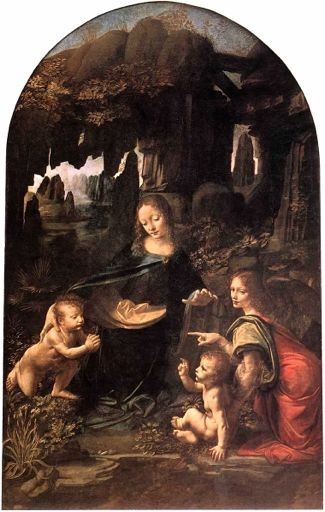
Archangel Uriel (r) in the Virgin of the Rocks (Louvre version) by Leonardo da Vinci, 1483–86
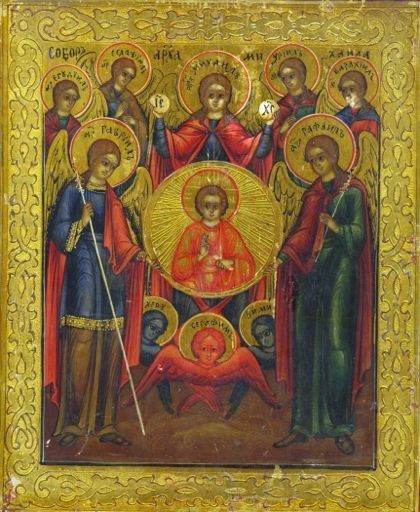
“The Angelic Council” (“The Angelic Council”). Eastern Orthodox Church icon of the “Seven Archangels” From left to right: St. Jehudiel, St. Gabriel, St. Selatiel, St. Michael, St. Uriel, St. Raphael, St. Barachiel. Beneath the mandorla of Christ Emmanuel are representations of Cherubim (blue) and Seraphim (red).
The Seven (classes of) Archangels are said to be the guardian angels of nations and countries, and are concerned with the issues and events surrounding these, including politics, military matters, commerce and trade: e.g. Archangel Michael is traditionally seen as the protector of Israel and of the ecclesia (Gr. root ecclesia from the New Testament
passages), theologically equated as the Church, the forerunner of the spiritual New Israel.
Angels:
The “Angels” or malakhim, i.e. the “plain” angels (ἄγγελοι, pl. of the Greek word ἄγγελος, angělős, i.e. messenger or envoy), are the lowest order of the angels, and the most recognized, as they are the closet to man (“Guardian Angel”). They are the ones most concerned with the affairs of living things.
Within the category of the angels, there are many different kinds, with different
functions. The angels are sent as messengers to mankind. Angels (and specially one’s own “Guardian Angel”) inspire us during sleep.
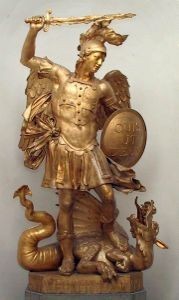
Raphael (Standard Hebrew רְפָאֵל, Rafa’ēl, “It is God who heals”, “God Heals”, “God, Please Heal”) is an archangel of Judaism and Christianity, who in the Judeo-Christian tradition performs all manners of healing. In Islam, Raphael is the same as Israfil. Raphael is mentioned in the Book of Tobit, which is accepted as canonical by Catholics, Orthodox, and some Anglo-Catholics, and as useful for public teaching by Lutherans and Anglicans. Raphael is generally associated with the angel mentioned in the Gospel of John as stirring the water at the healing pool of Bethesda.
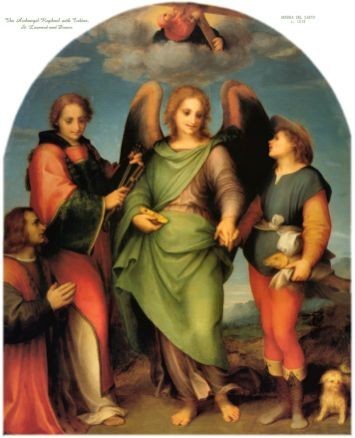
Archangel Raphael with Tobias


Francesco Botticini (1446O1497) with Archangels Michael (l), Raphael (m) and Grabriel (r) accompanying the handicapped Tobias
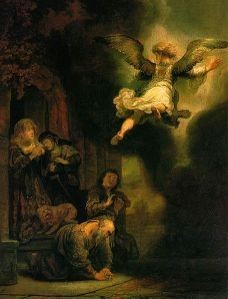
Rembrandt van Rijn (1606–1669): ArchangelRaphael leaving Tobias and his family
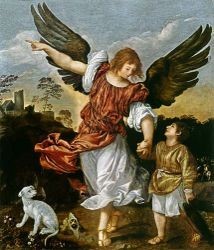
Titian:Archangel Raphael guiding Tobias
Tiziano Vecelli or Tiziano Vecellio (ca.1488–1576) was an Italian painter, the most important member of the 16th]century Venetian school.

Titian (ca. 1488–1576) self portrait
Recognized by his contemporaries as “The Sun Amidst Small Stars” (recalling the famous final line of Dante’s Paradiso), Titian was one of the most versatile of Italian painters, equally adept with portraits, landscape backgrounds, and mythological and religious subjects. His painting methods, particularly in the application and use of color, would exercise a profound influence not only on painters of the Italian Renaissance, but on future generations of Western art.
During the course of his long life, Titian’s artistic manner changed drastically but he retained a lifelong interest in color. Although his mature works may not contain the vivid, luminous tints of his early pieces, their loose brushwork and subtlety of tone are without precedent in the history of Western art.
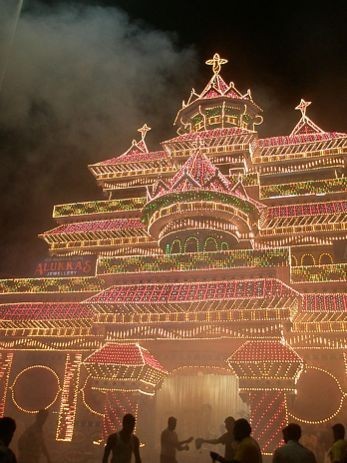
Pandal in Ollur Junction made for the annual feast of Archangel Raphael. Anthony’s Forane Church, Ollur, was built by Chiramel Chakoru Palu, a resident of Ollur, who got the permission from Raja of Cochin. The foundation stone of the church was laid by Rev. Marollical Poulose. The church was built in the Gothic architecture style in the period 1883-1893. The Ollur Forane church in Ollur, Thrissur in Kerala (India) is one the best models of Christian architecture in India.

Modern imagination of Archangel Raphael
Rudolf Steiner:
“Man will eventually evolve to an august
rank among the celestial hierarchies. Presently, there are nine hierarchies above us or ten if we count the Godhead (Trinity). In the future, we will rise to be the tenth hierarchy. By their very nature the higher Hierarchies merely reflect the divinity [i.e., the Godhead]. They have no freedom and the question of freedom does not arise. The destiny of man is different. Man is to gain new and enhanced faculties by struggling with adversity caused by the left-behind [i.e., abnormal] members of the Hierarchies [i.e., evil spirits; counter forces]. At the same time this gives him the possibility of falling into error. It is part of the divine plan that he shall work out his salvation that he shall evolve through his own efforts. In the course of aeons man will become the Tenth Hierarchy in his own right, because he will have earned it.”
And:
“We will evolve ultimately to become “God the Father.” Mankind shall have gradually achieved the transformation of his own being into what is called in Christianity ‘the Father.”
And:
“Of all created beings, man is the most complex. He car. He can only be considered from various points of view and these are endless.”
Rudolf Steiner on the Spiritual Hierarchies in Düsseldorf, Germany in 1909:
“This course of lectures will take us into the high spiritual regions we shall be led from the earth, where we live, not only into the wide physical spaces of our universe, but also be uplifted to those spiritual worlds, from which this whole physical universe has derived its origin.
Such a course will show us, that the fundamental object of all knowledge and all wisdom is to solve the greatest problem of all the problem of humanity. In order to make the human being understandable, explanatory facts have to be brought from far away. Abe necessary that those who wish to follow this course acquainted with the fundamental conceptions of Anth although it is true that all
Anthroposophists are acquainted with them in a general way. In these lectures we may rise in spirit to very exalted spheres, but we shall always endeavor to bring those facts which lie so far afield near to you and make them as comprehensible as possible.
When we have to speak of what we call the Spiritual Hierarchies, it means that our souls’ gaze must rise to those beings who, in the sphere of our earth, have a higher existence than man. In the visible world we can only progress to beings that represent four degrees of one hierarchy, i.e., the mineral world, the plant world, the animal world and the human world. Above man begins a world of invisible beings, through the knowledge of the supersensible world, and man is able (as far as it is possible for him) to rise a certain distance towards
those beings and powers, which are the continuation in the invisible world of the four grades found within the realm of the earth. The knowledge and investigation which lead us into those regions has not, as you all know, come into existence only at our present time in evolution. There is what we may call a primeval world-wisdom; all that man can fathom, all that he can know and realize, all that he has gained in ideas and
conceptions, all that he has attained through clairvoyant imagination, inspiration, and intuition, all has been lived before, and known before, by those Beings who are higher than he. He only follows to say, i their track. To make use of a trivial example: the watch 29/44 fi the idea, and
then he makes the watch according to the iatu.watch. made after the maker’s ideas which preceded the watch; afterwards everyone can study and observe for himself from what ideas the watch was made, he can follow up the thoughts of the watchmaker. At the present point of evolution it is indeed only this kind of connection that man can have with primeval world-wisdom and with the spiritual beings that stand above him. Spiritual beings had first those imaginations, inspirations, intuitions, those ideas and thoughts according to which the world, as we see it, was formed. Man finds these thoughts and ideas in the world again; when he rises to clairvoyant vision, he finds the imaginations, inspirations, and intuitions, by the help of which he can penetrate into the world of those spiritual beings. We can, the that before our world
came into being there already existed t of which we are going to speak: it is the PLAN OF THE WORLD.
How far must we go back, while still remaining within the limits of reality, if we want to come into touch with that primeval world-wisdom? Must we go back to some time or other in the historical past, when some great teacher was teaching? We can certainly learn a great deal if we do; but to come into touch with true primeval world-wisdom we must go back to the time when there was no outwardly visible earth, when no world visible to the outer senses was as yet in existence. It was from out [of] that wisdom itself that the world came forth. But this wisdom, out of which spiritual beings formed our world, was imparted to man later. Man with his thoughts could see behind those thoughts, could realize the
thoughts according to which spiritual beings have built the world. After this primeval wisdom, this wisdom of the creators of the world had worked through many forms, it appeared in a form known to many of you: after the great Atlantean period it appeared in those ancient, holy Rishis, the great teachers of India, during our first epoch of civilisation. With these sublime Rishis the primeval wisdom expressed itself in a form which the man of the present day can but little understand. The human
capacities of feeling and thinking have greatly changed since the times when the great teachers of India taught man in the first epoch of civilisation after Atlantis; and if the words which came from the Rish
were simply repeated as they were said, there would be 30/44 sc in the whole earth who could hear anything more in the….waday than just words and again words. One has need of other capabilities of feeling than those at present existing, in order to understand the wisdom which was given to humanity in the first epoch after Atlantis. For all that is found in the best books regarding primeval world-wisdom, is but a faint echo of what this really is which in many ways is but a deceptive, obscured wisdom. However grand and sublime the Vedas appear to us, however beautiful the songs of Zarathustra sound, and however magnificent the language in which the ancient wisdom of Egypt speaks, so that we can never sufficiently admire it; still, all that has been written down gives us but a dim, dull reflection of the wisdom of Hern
grand teaching of Zarathustra, or of the sublime knowledge Ancient Rishis proclaimed. This sublime wisdom has been pre guarded for humanity; it was always to be found in certain ver, circles of people who watched over what is called the knowledge of the Mysteries. In the Mysteries of India, Persia, Chaldea, Egypt, and in the Christian Mysteries, all the primeval wisdom of humanity has been safely preserved up to our times. Up to a short time ago it was only in those narrow circles, that not book-wisdom, but living wisdom, could be found. For certain reasons which will be made clear in this course of lectures, our time has been chosen for extending to larger masses of people that which has been kept alive by those little groups. The original wisdom of the Rishis, for instance, has never lost life. It permeated, like the fountain of youth, the age which we regard as the beginning of our era. The very holy wisdom which the Rishis gave to man was continued through Zarathustra and his pupils, through the Chaldean and Egyptian teachers. It also flowed in the words of Moses, and it came forth again with. an altogether new impulse, as from the fountain of life, with the appearance of the Christ upon earth. It then became so deep, so intrinsically internal, that it could only gradually flow again into humanity. Thus we see that since the outward declaration of Christianity, the primeval world wisdom has penetrated but slowly and gradually into humanity from most
elementary beginnings. Its messages are there, they ar the Gospels and in other
Christian writings which inclu วน dc 31/44 the holy Rishis, in a new form; like a new birth out of a new fountain. b.. how could these messages be understood at the beginning of the era for whose purification Christianity had been created? Through the Gospels it was least of all understood; they only attained very gradually to further comprehension and in many ways to a still further obscuration, and to-day the Gospels are, in truth, the most sealed of all books for the larger part of humanity books which will only be first understood by a future age which will have refreshed itself at the source of the original world-wisdom. But the treasures hidden in the Christian revelationkeen preserved, treasures no other than those of the Eastern renewed by means of fresh forces They have been guard circles which were the continuation of Mystery Societ Brotherhood of the Holy Grail, and finally in the Brotherhood of the Rosy Cross. These treasures of truth have been kept well hidden and have been accessible only to those who through severe trials had prepared themselves for the living wisdom. Thus the treasures of the Eastern and Western wisdom, through all the centuries of evolution from the beginning of our era, were made almost inaccessible to the larger mass of humanity.
Only a little trickled through here and there to the outer world: the most part remained a secret of the new Mysteries. Then came a time when some of the contents of primeval wisdom, treasured in narrow circles, was allowed to be given out to larger masses of humanity in a language comprehensible to them. Since the last third of the nineteenth century or
thereabouts one can speak of this world wisdom in a more or less unveiled form. It is only because certain things have taken place in the spiritual worlds that the Guardians of the Mysteries received permission to allow some of the ancient wisdom to penetrate to the outer world. All of you, my dear friends, know the course of development of the Anthroposophical Society. You know how the ice in which its development was bound was, so to say, broken by those words of wisdom, revealed in a way which I am not going to enter into now the stanzas of Dzyan. Those stanzas of Dzyan, of the secret teaching, contain in truth some of the deepest and most important wisdom; they have in them much of that which coming from the teaching of the holy Rishis has flowed through the sanctuaries of the East. They contain also much of what has streamed into Western Europe since the Christian rejuvenation. For the stanzas of Dzyan do not include only the wisdom which had to be kept exclusively for the East, but also a great deal of that which streamed as a clear light through the centuries of our time, through the Middle Ages into the Mystery Schools of the West. Much that is to the stanzas of Dzyan will only be gradually understood in a may well be said here that the wisdom of the stanzas of Dzy in It ch a kind that it cannot yet be understood in the widest anthroposophical circles, or fathomed with the exoteric capabilities of the present day.
After the first ice had been broken in this way, the time came when one could speak more openly from the sources of Western occultism, which is no other than the occultism of the East transplanted and continued in a way that has adapted itself to new circumstances and conditions of physical and spiritual life.
The time has come when one can speak from those ever living sources of occultism which have been faithfully treasured in the Mysteries of the Rosy Cross. There is no wisdom of the East which has not streamed into Western occultism and into the teaching and investigations of the Rosy Cross; in them is to be found absolutely all that the great teachers of the East ever had in their keeping. Nothing, nothing whatever of that
which is to be found in the Eastern wisdom is lacking in the wisdom of the West. The only difference if it can be called a difference is that Western occultism has to include the whole of the Eastern wisdom and teaching and, without losing anything, to blend it with the light which has been kindled in humanity through the Christ Impulse. When one speaks of Western occultism, of that which has its derivation from the hidden Western Rishis (whom certainly no eye hath seen) it is impossible to say that in it is wanting one single iota, one single shred of the Eastern wisdom. Only it had all to be brought forth again fresh and new from the fountain-head of the Christ Impulse. All the great treasures of wisdom which were first revealed by the holy Rishis regarding superhuman worlds and supersensible existence, resound in the description we have
to give of the spiritual hierarchies and their reflection in the physical world. Just as the geometry of Euclid has not become something different from what it used to be, because one teaches and learns it with new human capabilities, just as little has the wisdom of the holy Rishis changed because we learn and teach it with the new capabilities which have been kindled in us by the Christ Impulse. Therefore much of what we have to say about the spiritual worlds can be called Easte There must not be any misunderstanding in these th misunderstandings happen so easily. Those who will not fre of a misconception, in order to come to understanding, ca m. d es sily misinterpret what, for instance, was said yesterday at the Easter lecture. They might assert about the so-called truths of Buddha, that I had said that the Buddha had taught and revealed the truths about life and life’s pain as follows: ‘birth is pain, illness is pain, old age is pain, death is pain; to be separated from those one loves is pain, not to be united with what one loves is pain, not to have what one desires is pain’ and that I said: ‘Let us look at those who, in the times after Christ, really understood the Christ Impulse; for all the holy truths of the Buddha about the pain of life have no more their full importance; something has been created by the Christ Impulse that is like a cure for the pain of life.’ The Buddha taught: ‘Birth is pain’; but those who understood the Christ would answer that through birth we enter into a life shared with the Christ, and through the Christ’s share in it the pain of life will be extinguished. Illness will also be extinguished through the healing power of the Christ Impulse, and there is no more pain in illness for one who understands Christ, and death also has no more pain for him who understands Christ. Yet someone might reply to this ‘Yes, but I could point to the Gospels to show that also there you will find it said that illness is pain, life is pain’: and one might superficially come to the conclusion: ‘We have those modern religious documents, but what they contain can also be found in Buddhism, therefore religions are not making progress, there is no evolution in them. All religions say the same things, but you have spoken of a progress, you expounded to us how, with the help of Christianity, the old truths of Buddhism would not be true any more.’ If anyone were to say this he would be guilty of a very serious misunderstanding. For that was not said: everything indeed was said with the exception of the last
sentence. It is very important that this very subtle question should be rightly understood. A fanatic can never understand with precision, but a man who is objective can. No one who speaks with knowledge of Rosicrucian wisdom will ever expound anything that would be against any of the writings of the great Buddha, or say that anythi untrue. Every man who speaks from the sources of Rosicr shares the conviction of Buddha, no one denies it. ‘Yes,’ such is m S, ‘what thou, great Buddha, through thy inner illumination, hast seen of the great truths about pain and life is exactly true, it is true to its last iota.’ Nothing, absolutely nothing will be taken away from it. All of it remains as it was. And it is just because all of it remains as it was, because all is true of what the Buddha said about the pain of life, of illness, of old age and of death, just because of this, the Christ Impulse is such a powerful and important saving help to us, for it is just this which lifts the pain, because it is true that pain would be there, if the world could not be lifted beyond and above it through that great Impulse. Why could the Christ work effectively? Because the Buddha had spoken the truth. Humanity had to be brought down out of the spiritual heights where the primeval world wisdom is active in its purest form;
man had to be led to independence, through physical existence with which life’s pain and illness are bound up, and the great healing help had to oppose those unavoidable facts in the course of further evolution. Does that man deny the reality of facts who, while declaring that these realities exist, hold at the same time that remedy has been given us by which the facts, about which those truths have been said, can be brought to a salutary development; does he who says this deny any existing reality? Oh! in those heights of existence where we must look for the spheres of the spiritual hierarchies there Buddhism is not opposed to Christianity, nor Christianity to Buddhism; there the Buddha gives his hand to the Christ, and the Christ to the Buddha. But every misconception regarding human evolution, every misconception as to its ascending development, is a misconception also of that spiritual act in our earthly evolution which is the Act of Christ.
Thus nothing is denied. of the wisdom of the East, the wisdom which has brought down to us the teaching of the holy Rishis, and with it the primeval world-wisdom, which through such long epochs of time has ever been streaming into humanity. But, all through those very long epochs, large masses of humanity could not penetrate to the sources of that wisdom, could only understand it with great difficult precisely the understanding of it which came with such di ancient Atlantean times, before the great catastrophe, when t of humanity
were still clairvoyant with the thin ancient clairvoyance, they beheld something quite different when they looked upwards to the spaces of heaven, to the spiritual hierarchies, from what they saw in the times after Atlantis when the larger part of humanity had lost its clairvoyance and so could gaze only with its physical eyes into the physical distances of the heavens. Therefore, in the times before the Atlantean catastrophe, it would have been quite senseless to speak to them of the heavenly bodies spread out in space as they are to-day. The clairvoyant human eye gazed into heavenly distance and saw the spiritual worlds. In those times there would have been no sense in speaking of Mercury or of Neptune or of Saturn, etc., as our astronomy speaks. The way astronomy speaks of the spaces of the world and what they contain is merely a reflection of what is seen by our own physical sight when it looks into depths of the sky. This did not exist for the ancient clairvoyant humanity of Atlantis; when they looked upwards, they did not see physically-limited stars, what the physical eye sees to-day is but the outer physical expression of the spiritual realities which people then beheld. When looking to-day with one’s physical eye through a telescope at the place where Jupiter is, one perceives a physical globe surrounded by moons. What was seen by the man of Atlantis when he lifted his clairvoyant gaze to that same point which we look at to-day with our physical eyes? The Atlantean’s eyes would have seen as little of what our sight sees to-day, as we should if we looked at a light through a thick autumn fog. The eye of the Atlantean would not have seen the physical star Jupiter, but he would have seen that which is also united with Jupiter to-day, which the man of the present day does not see: the aura of Jupiter, a totality of spiritual beings, of which the physical Jupiter is only the external expression. Thus did the gaze of man, before the Atlantean catastrophe, sweep round the spaces of the world seeing everywhere its spiritual content. He could speak only of the spiritual, for it would have had no meaning to speak of physical stars, when the physical eye was not yet opened as it is to-day. Looking into th the universe man saw spiritual beings the spiritual hie actually saw beings. We can compare the changes that too further evolution in this way: let us suppose that we are going of a thick fog; we do not see separate lights, everything is surrounded by
aura or fog. The fog lifts and disperses, the separate lights are visible, but their aura becomes invisible … This is only a physical process which must serve for an example. But the ancient eye saw the aura of Jupiter, it saw spiritual beings in that aura which at certain points of their evolution were united to Jupiter. Humanity then developed further, to the attainment of physical sight. The aura remained: men could no longer see it, but the physical body in the center became ever clearer and clearer, spiritually it was lost to sight as its corporeal part became visible. But the knowledge of the spiritual, the knowledge of the beings surrounding the star was kept and guarded in the holy Mysteries.
All the holy Rishis speak of that knowledge. In the times when men already saw only in a physical way, the Rishis spoke to them of the spiritual atmospheres, of the spiritual inhabitants of those spheres which are spread out in the spaces of the world.
Consider what the situation then was. In the centers of knowledge, spiritual beings were spoken of which surround the spheres of the universe. Outside where the physical eye was growing always sharper, physical matter was spoken of more and more. When the Ancient Rishis said the word Mercury (they did not use that word, but we take it as an example), did they mean by it the physical orb of that name? No! even the ancient Greeks did not use it in that sense; what they meant was the totality of spiritual beings belonging to that planet. Spiritual world and spiritual beings were spoken of when, in the centers of secret knowledge for instance, the word Mercury was pronounced. When the disciples of that sacred knowledge spoke of the Moon, Mercury, Venus, Sun, Mars, Jupiter, Saturn pronouncing these words in their different languages, they expressed the gradations of spiritual beings. When those names are used to-day, only the coarsest part is meant of that which was originally understood by Moon, Mercury, and Venus. The principal part is just what is omitted to-day; the ancient teacher of wisdom said the on and with that word he evoked the idea of a great spiritual world. When he, pronouncing the word ‘Moon’, pointed to the place in heaven where the moon was, he felt in his consciousness that it was the lowest stage of the spiritual hierarchies, but the man to whom he was showing it, who was getting ever further from that spiritual sight because humanity was growing more and more physical, saw only the physical moon, and called it ‘Moon.’
One single word for two things which, though they certainly belong to each other, call forth quite different ideas in man. It was the same when the sages of the sacred knowledge pointed to Mercury, Sun, or Mars. Thus we see that the two currents grew always further apart in humanity, the spiritual one describing something quite different from the material current. In the sacred Mysteries these words which later became the mere names of physical planets were always understood as descriptions of spiritual worlds and gradations of spiritual realms. The outer world always understood it materially up to the time of modern Mythology I use the word purposely which is called Astronomy. And as Anthroposophy has recognised the full worth of all the other Mythologies, it has also, as you will understand, given full value to that Mythology which is called modern Astronomy, which sees only space and in it, the physical world-spheres as physical orbs. But to him who knows, modern Mythology is only a special phase of all Mythologies. What the ancient inhabitants of Europe said in their myths about gods and stars, what the Romans gave in their Mythologies, and what appeared as the obscured Mythology of the Middle Ages, lead up in a straight line to the wonderful and admirable discoveries of Copernicus, Kepler, and Galileo. A future will come when modern Mythology will be spoken of somewhat in this way: ‘There was a time when people found it right to place a material sun as the middle point of an ellipse and let the planets rotate within it, and spin round themselves on their own axes in different ways; they arranged a world system in that way, as people of earlier times also did. Today’ so will that future age think ‘all that is only legend and fairy tale.’ Yes, that future age will come, although the man of the present who laughs at former Mythologies thinks it impossible that one.
could ever speak of Copernican Mythology. But this consideration will make clear to us how through the same words something ever more different may be meant. In spite of this the true primeval wisdom has always been cultivated and has always continued; it has however always been less understood exoterically and its spiritual side less seen, the more it has been materially explained.
In the beginning of our era (the fifth Post-Atlantean Epoch), when there was a juvenescence of primeval wisdom, (in order that humanity should not lose all touch with that ancient wisdom), it was said in sharp, clear words, that when man looks at the outer space of the world and his physical eye sees only what is physical, the space is filled with spirit. It was the most intimate pupil of St. Paul, Dionysius the Areopagite, who said in clear-cut words: ‘There is not only matter out there in space; there is, for the soul which rises consciously into the spaces of universal existence, the spiritual part which stands above man in the evolution of existence.’ And he used words which sounded different from the old ones, for if he had used the old words everybody would have understood them in the material sense. The Rishis spoke of the spiritual hierarchies, they expressed in their language what the Greek and Roman wisdom still described when speaking of the ascending scale of worlds: of the Moon, of Mercury, Mars and Venus, Jupiter and Saturn. Dionysius, the pupil of the Apostle Paul had the same worlds in his mind as the Rishis, he repeated in clear cut words that here one had to do with spiritual realms, and he used words which he could be certain would be understood in their spiritual sense: he spoke of Angels, Archangels, Archai, Powers, Mights, Dominions, Thrones, Cherubim, and Seraphim. For now humanity had completely forgot what it once knew. Had it still been able to understand the connection between what Dionysius and the Rishis had seen, it would have grasped, while hearing on the one side of the Moon, and on the other side of the Mysteries of the Angels, that these were one and the same thing. It would have heard the word Mercury on the one hand and Archangel on the other, and would have known they were the same. The word ‘Archai’ spoken by the one, and ‘Venus’ by the other, were the same. And men would have understood that with the words ‘Sun’ and ‘Powers’ the same worlds were meant. With the name
‘Mars’ they would have felt that they had to rise to the Mights (Dynamis). When they heard Jupiter mentioned, they would have known that it was the same as when in the school of Dionysius, Dominions were described. Saturn corresponds to ‘Thrones’; but in wider circles this was not known any more, it could not be known. Thus there was on the one side a science of matter, which became ever more material, and the old names which once signified spiritual forces, were now used in a material sense. And on the other side, there was a spiritual life which spoke of Angels and Archangels, etc. which had lost its connection with the physical designations of these spiritual beings.
Thus we see how the primeval wisdom enters through Dionysius into the school which Paul had inaugurated, and how this new inauguration had to be penetrated by the ancient spirit. It is the task of modern Spiritual Science, or Anthroposophy to form once more the bond which must unite the physical to the spiritual, the bond between the earth and the spiritual hierarchies. It is impossible for those who do not know where their ideas about the outer world of the senses come from, to realize the other, the spiritual side of knowledge. This will he particularly noticeable when we have to deal with those writings which, although they are but a faint echo of the primeval cosmic wisdom, can still be understood in the light of that wisdom.
Let me show you an example of the difficulty there is in understanding writings which come down to us from that primeval wisdom. It is an example out of the Song Celestial, the Bhagavad Gita, where a sentence throws a very significant light on the connection between human life and the hierarchies. It is the following: (8th Chap. beginning with 23rd verse) ‘I will explain unto thee, oh man seeking for truth’ (it is thus generally translated) ‘under what
circumstances those who know the Eternal leave the earth through the gate of death, to be later reborn or not. I will tell thee: Behold the fire, behold the day, behold the time of the waning moon, behold the half year when the sun is high – those who die at that time, who die in fire, in the day, in the time of the waxing moon, those enter through the gates of death into Brahma, but those who the in the sign of the smoke, in the night, when the moon is waning, in the half year when the sun stands low, these when they leave the world and pass through the gates of death enter only into the light of the moon, and return again to the world.’ Here you have, my dear Anthroposophical friends, a sentence from the Bhagavad Gita, in which it says that the condition of man’s progress and of his reincarnation depends on whether he dies in the sign of the light, by day, with the waxing moon, during the half year when the sun stands high, or whether he dies in the sign of the smoke, by night, when the moon wanes and when the sun is low. It is said that this refers to the material sun. Of those who die in the sign of the fire by day, with the moon waxing, and during that half of the year when the sun is high, it is said that they do not need to return. Those who die in the sign of the smoke, by night, with the moon waning, and when the sun is low, must return into the world. This sentence out of the divine song of the East presents the greatest difficulty to all those who want to explain it within the limits of exoteric life. It can be explained only when it is illuminated by the light of spiritual knowledge, by the light in which it was received and written, the light which streams out of the Mystery schools, which can be increased. which has known its juvenescence through Christianity and which shows us how to find the link which binds the names Moon to Angels, Mercury to Archangels, Venus to the Archai and so on. With its help we shall find the key to such sentences as the one we gave as an example. Our course of studies will start from the explanation of this sentence in the Bhagavad Gita, a thing which is impossible in exoteric life; and after we have found the key to it, we shall pass on to further explanations of the spiritual hierarchies.”
Bhagavad Gita
(Sanskrit:e madbhagavadgītā, Sanskrit pronunciation: [‘bhəgəvəd gi:’ta:]), The Song of Bhagavan, often referred to as simply the Gita, is a 700-verse scripture that part of the Hindu epic Mahabharata. It is a sacred text of the Hindus, and any udent of Spirituality.
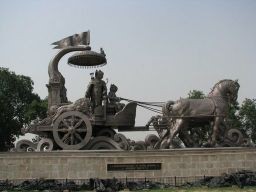
Bronze chariot, depicting discourse of Krishna and Arjuna in Kurukshetra
The Gita is set in a narrative framework of a dialogue between Pandava prince Arjuna and his guide Lord Krishna. Facing the duty to kill his relatives, Arjuna is “exhorted by his charioteer, Krişhņa, among others, to stop hesitating and fulfill his Kşatriya (warrior) duty as a warrior and kill.” In this appeal to ksatriyadharma (heroism) is “a dialogue […] between diverging attitudes concerning and methods toward the attainment of liberation (moksha).
The Bhagavad Gita presents a synthesis of
the Brahmanic concepts of Dharma, theistic bhakti, the yogic ideals of liberation through jnana, and Samkhya philosophy.
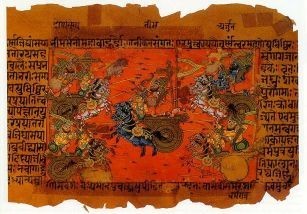
An ancient manuscript illustration of the battle of Kurukshetra, fought between the Kauravas and the Pandavas, recorded in the Mahabharata
Numerous commentaries have been written on the Bhagavad Gita with widely differing views on the essentials. Vedanta commentators read varying relations between “Self” and Brahman in the text:
Advaita Vedanta sees the non-dualism of Atman and Brahman as its essence, whereas Bhedabheda and Vishishtadvaita see Atman and Brahman as both different and non-different, and Dvaita sees them as different. The setting of the Gita in a
battlefield has been interpreted as an allegory for the ethical and moral struggles of the human life.
The Bhagavad Gita’s call for selfless action inspired many leaders of the Indian independence movement including Mohandas Karamchand (Mahamatma) Gandhi, who referred to the Gita as his “spiritual dictionary.”
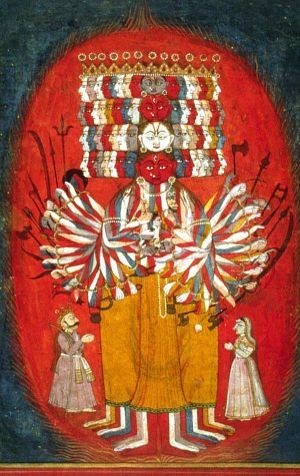
Krishna displays his Vishvarupa (Universal Form) to Arjuna on the battlefield of Kurukshetra (chapter 11).
The Bhagavad Gita’s call for selfless action inspired many leaders of the Indian independence movement including Mohandas Karamchand (Mahamatma) Gandhi, who referred to the Gita as his “spiritual dictionary.”
Krishna displays his Vishvarupa (Universal Form) to Arjuna on the battlefield of Kurukshetra (chapter 11).
The Bhagavad Gita is the sealing achievement of this Hindu synthesis, [13] incorporating various religious traditions. According to Hiltebeitel, bhakti forms an essential ingredient of this synthesis,
which incorporates bhakti into the Brahmanic fold.
According to Deutsch and Dalvi, the Bhagavad Gita attempts “to forge a harmony” between different strands of Indian thought: jnana, dharma and bhakti. Deutsch and Dalvi note that the authors of the Bhagavad Gita “must have seen the appeal of the esoteriologies both of the “heterodox” traditions of Buddhism and Jainism and of the more “orthodox” ones of Samkhya and Yoga”, while the Brahmanic tradition emphasized “the significance of dharma as the instrument of goodness”.
Scheepers mentions the Bhagavat Gita as a Brahmanic text which uses the shramanic and Yogic terminology to spread the Brahmanic idea of living
according to one’s duty or dharma, in contrast to the yogic ideal of liberation from the workings of karma.
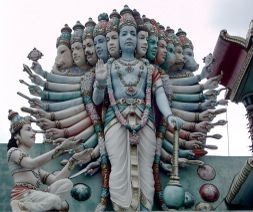
Krishna displays his Vishvarupa (Universal Form) to Arjuna on the battlefield of Kurukshetra, described in Visvarupa-Darsana yoga (chapter 11)
According to Basham, the Bhagawat Gita combines many different elements from Samkhya and Vedanta philosophy. In matters of religion, its important contribution was the new emphasis placed on devotion, which has since remained a central path in Hinduism. In addition, the popular theism expressed
elsewhere in the Mahabharata and the transcendentalism of the Upanishads converge, and a God of personal
characteristics is identified with the Brahman of the Vedic tradition. The Bhagavad Gita thus gives a typology of the three dominant trends of Indian religion: dharma-based householder life, enlightenment-based renunciation, and devotion-based theism.
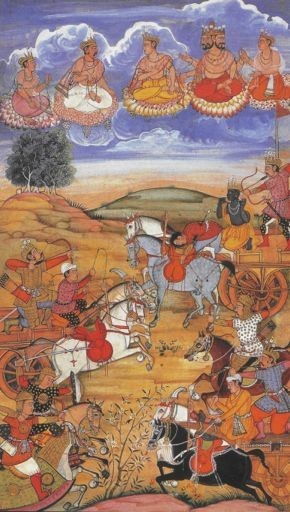
Illustration of the battle of Kurukshetra, Arjuna (far right), with Krishna as the charioteer, is battling the Kauravas as the gods look down.